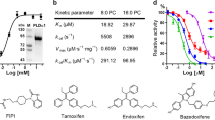Abstract.
Phospholipase D (PLD) hydrolyzes the phosphodiester bond of the glycerolipid phosphatidylcholine, resulting in the production of phosphatidic acid and free choline. Phosphatidic acid is widely considered to be the intracellular lipid mediator of many of the biological functions attributed to PLD. However, phosphatidic acid is a tightly regulated lipid in cells and can be converted to other potentially bioactive lipids, including diacylglycerol and lysophosphatidic acid. PLD activities have been described in multiple organisms, including plants, mammals, bacteria and yeast. In mammalian systems, PLD activity regulates the actin cytoskeleton, vesicle trafficking for secretion and endocytosis, and receptor signaling. PLD is in turn regulated by phosphatidylinositol-4,5-bisphosphate, protein kinase C and ADP Ribosylation Factor and Rho family GTPases. This review focuses on the lipid precursors and products of mammalian PLD metabolism, especially phosphatidic acid and the roles this lipid performs in the mediation of the functions of PLD.
Similar content being viewed by others
Author information
Authors and Affiliations
Corresponding author
Additional information
Received 9 May 2005; received after revision 9 June 2005; accepted 30 June 2005
Rights and permissions
About this article
Cite this article
Jenkins, G.M., Frohman, M.A. Phospholipase D: a lipid centric review. Cell. Mol. Life Sci. 62, 2305–2316 (2005). https://doi.org/10.1007/s00018-005-5195-z
Published:
Issue Date:
DOI: https://doi.org/10.1007/s00018-005-5195-z




